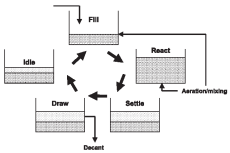Difference between revisions of "Sequencing Batch Reactors"
(Created page with "Setup of a SBR SBR in operation A sequencing batch reactor (SBR) is an aerobic treatment pro...") |
|||
| Line 4: | Line 4: | ||
A sequencing batch reactor (SBR) is an aerobic treatment process that is highly efficient in removing organic matter, suspended solids and even nutrients in wastewater. Unlike the traditional activated sludge method that uses multiple tanks, the SBR treats each batch individually in a single tank. There are some obvious benefits of SBR technology as it has a smaller footprint, is less expensive to construct and is somewhat easier and less expensive to operate and maintain. | A sequencing batch reactor (SBR) is an aerobic treatment process that is highly efficient in removing organic matter, suspended solids and even nutrients in wastewater. Unlike the traditional activated sludge method that uses multiple tanks, the SBR treats each batch individually in a single tank. There are some obvious benefits of SBR technology as it has a smaller footprint, is less expensive to construct and is somewhat easier and less expensive to operate and maintain. | ||
| − | Several options for utilizing sequencing batch reactors (SBRs) are available. For example, the wastewater treatment plant for the public market at San Fernando, La Union, Philippines uses an [[ | + | Several options for utilizing sequencing batch reactors (SBRs) are available. For example, the wastewater treatment plant for the public market at San Fernando, La Union, Philippines uses an [[Anaerobic_Baffled_Reactor_(ABR) 2|anaerobic baffled reactor]] for primary treatment and an SBR for secondary treatment. The system can handle a flow up to 200 cubic meters per day of high-strength market wastewater. It was constructed by local contractors for a price of 6 million Philippine pesos. |
At a treatment plant in Halong City, Vietnam, the installation of the SBR involved 3.5km of pressure sewage pipelines, eight underground sewage pumping stations and 10km of gravity sewers. | At a treatment plant in Halong City, Vietnam, the installation of the SBR involved 3.5km of pressure sewage pipelines, eight underground sewage pumping stations and 10km of gravity sewers. | ||
Revision as of 23:03, 28 September 2016
A sequencing batch reactor (SBR) is an aerobic treatment process that is highly efficient in removing organic matter, suspended solids and even nutrients in wastewater. Unlike the traditional activated sludge method that uses multiple tanks, the SBR treats each batch individually in a single tank. There are some obvious benefits of SBR technology as it has a smaller footprint, is less expensive to construct and is somewhat easier and less expensive to operate and maintain.
Several options for utilizing sequencing batch reactors (SBRs) are available. For example, the wastewater treatment plant for the public market at San Fernando, La Union, Philippines uses an anaerobic baffled reactor for primary treatment and an SBR for secondary treatment. The system can handle a flow up to 200 cubic meters per day of high-strength market wastewater. It was constructed by local contractors for a price of 6 million Philippine pesos.
At a treatment plant in Halong City, Vietnam, the installation of the SBR involved 3.5km of pressure sewage pipelines, eight underground sewage pumping stations and 10km of gravity sewers.
More information on SBR technology.
Acknowledgements
- Indah Water Konsortium of Malaysia for preparing the PowerPoint presentations.


